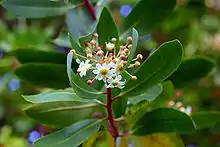Drimys winteri
Drimys winteri, the winter's bark or canelo, is a slender tree in the family Winteraceae, growing up to 20 m (66 ft) tall. It is native to the Magellanic and Valdivian temperate rain forests of Chile and Argentina, where it is a dominant tree in the coastal evergreen forests. It is found below 1,200 m (3,937 ft) between latitude 32° south and Cape Horn at latitude 56°. In its southernmost natural range it can tolerate temperatures down to −20 °C (−4 °F).
| Drimys winteri | |
|---|---|
 | |
| Scientific classification | |
| Kingdom: | Plantae |
| Clade: | Tracheophytes |
| Clade: | Angiosperms |
| Clade: | Magnoliids |
| Order: | Canellales |
| Family: | Winteraceae |
| Genus: | Drimys |
| Species: | D. winteri |
| Binomial name | |
| Drimys winteri Jordan Forst. & G. Forst. | |
The leaves are lanceolate, glossy green above, whitish below and can measure up to 20 cm (8 in). The flowers are white with a yellow center, and consist of a great number of petals and stamens. The fruit is a bluish berry.
History
When Sir Francis Drake sailed round the world in 1577-80, of the four ships accompanying the Golden Hind at the outset, the only ship that successfully rounded Cape Horn with him was the Elizabeth, captained by John Wynter; the two ships separated in a storm and Winter turned back. Presumably he had sickness on board, for he sent a boat ashore to search out medicinal herbs. He returned in 1579 with a supply of Drimys bark, and for centuries before vitamin C was isolated, "Winter's Bark" was esteemed as a preventive and remedy for scurvy— correctly so, for an infusion of D. winteri sustained Captain James Cook and his crew in the South Pacific, and the naturalist accompanying his voyage of exploration, Johann Reinhold Forster, was the first to officially describe and name D. winteri.[2]
Cultivation

Drimys winteri is grown in cool moist climates[3] as an ornamental plant for its red-brown bark, bright green fragrant leaves and its clusters of creamy white jasmine-scented flowers.
The species grows well in southern Great Britain, flourishing as far north as Anglesey. Specimens brought from the southern forests of Tierra del Fuego and planted in the Faroe Islands have proven to be especially hardy.[4]
This plant has gained the Royal Horticultural Society's Award of Garden Merit.[5][6]
It has been planted in the North Pacific Coast of the United States.[7]
Other uses
Canelo wood is reddish in color and heavy, with a very beautiful grain. It is used for furniture and music instruments. The wood is not durable outdoors because continuous rainfalls damage it. The wood is not good for making bonfires because it gives off a spicy smoke.
The bark is gray, thick and soft and is used as a pepper replacement in Argentina and Chile. The peppery compound in canelo is polygodial.[8]

Notes
- Botanic Gardens Conservation International (BGCI) & IUCN SSC Global Tree Specialist Group (2018). "Drimys winteri". IUCN Red List of Threatened Species. 2018: e.T61968097A135698496. Retrieved 22 April 2020.
- Alice M. Coats, Garden Shrubs and Their Histories (1964) 1992, s.v. "Drimys".
- John L. Creech, providing American garden notes for Coats 1992, remarks of D. winteri and Tasmanian D. aromatica, both grown in British gardens, "These two species have not had much success here"; Drimys winteri is grown in the San Francisco Botanical Garden Archived 2012-03-09 at the Wayback Machine: (Capt. Winter is identified as "William Winter").
- Højgaard, A., J. Jóhansen, and S. Ødum (eds) 1989. A century of tree planting in the Faroe Islands. Føroya Frodskaparfelag, Torshavn.
- "Drimys winteri". Royal Horticultural Society. Retrieved 1 June 2020.
- "AGM Plants - Ornamental" (PDF). Royal Horticultural Society. July 2017. p. 33. Retrieved 6 February 2018.
- "Drimys winteri in Washington Park Arboretum" (PDF). Seattle Government. Archived from the original (PDF) on 2009-03-24. Retrieved 2009-06-27.
- Muñoz-Concha, D., Vogel, H., Yunesc, R., Razmilic, I., Brescianic, L., and Malheiros, A., Presence of polygodial and drimenol in Drimys populations from Chile, Biochemical Systematics and Ecology, Volume 35, Issue 7, July 2007, Pages 434-438
References
- Hoffmann, Adriana (1997), Flora silvestre de Chile zona araucana: Una guía ilustrada para la identificación de las especies de plantas leñosas del sur de Chile (entre el río Maule y el seno de Reloncaví)., Santiago: El Mercurio. ISBN 956-7743-01-0.
External links
| Wikimedia Commons has media related to Drimys winteri. |
- History, botanical origin, description, etc. Hanburgy, Daniel and Friedrich August Flückiger (1879). Pharmacographia; a History of the Principal Drugs of Vegetable Origin... London: Macmillan and Co. pp 17–20.
- "Drimys winteri in Crarae Gardens, Scotland". Dendrological Plant Image Gallery. Retrieved 2009-06-27.
- . Encyclopædia Britannica (11th ed.). 1911.
